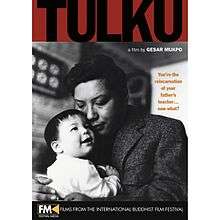
Tulku
A tulku (Tibetan: སྤྲུལ་སྐུ, Wylie: sprul sku, ZYPY: Zhügu , also tülku, trulku) is a custodian of a specific lineage of teachings in Tibetan Buddhism who is given empowerments and trained from a young age by students of his predecessor.
High-profile examples of tulkus include the Khyentses, the Kongtruls, the Dalai Lamas and the Karmapas.
Nomenclature and etymology
The word སྤྲུལ or 'sprul' (Modern Lhasa Tibetan [ʈʉl]) was a verb in Old Tibetan literature and was used to describe the བཙན་པོ་ btsanpo ('emperor'/天子) taking a human form on earth. So the 'sprul' idea of taking a corporeal form is a local religious idea alien to Indian Buddhism and other forms of Buddhism (e.g. Theravadin or Zen). Over time, indigenous religious ideas became assimilated by the new Buddhism; e.g. 'sprul' became part of a compound noun, སྤྲུལ་སྐུ་'sprul.sku' ("incarnation body" or 'tülku', and 'btsan', the term for the imperial ruler of the Tibetan Empire, became a kind of mountain deity). The term tülku became associated with the translation of the Sanskrit philosophical term nirmanakaya. According to the philosophical system of trikaya or three bodies of Buddha, nirmanakaya is the Buddha's "body" in the sense of the bodymind (Sanskrit: nāmarūpa). Thus, the person of Siddhartha Gautama, the historical Buddha, is an example of nirmanakaya. In the context of Tibetan Buddhism, tülku is used to refer to the corporeal existence of enlightened Buddhist masters in general.

Tulku (novel)
Tulku is a children's historical novel by Peter Dickinson, published by Gollancz in 1979. Set in China and Tibet at the time of the Boxer Rebellion, it features a young teenage boy orphaned by the violence, who flees with others to a Buddhist monastery. Dickinson and Tulku won two major awards for British children's books, the Whitbread Children's Book Award and the Carnegie Medal. The Carnegie Medal from the Library Association then recognised the year's outstanding children's book by a British subject.
Dutton published a U.S. edition within the calendar year under its Unicorn imprint.
Plot summary
Thirteen-year-old Theodore lives in a remote region of China at his father's Mission. When the violence of the Boxer Rebellion finally reaches them, Theodore escapes alone from its destruction. He soon becomes one companion of a formidable Englishwoman, "painted, blasphemous, gun-toting Mrs Jones". She is an amateur botanist and a former actress with an entourage.
The party flees bandits into Tibet and take refuge at a Tibetan Buddhist monastery. Theodore is briefly seen to be the Tulku, a great lama reincarnated; then the recently conceived child of Mrs Jones and her Chinese lover is identified as the one. Theodore is exposed to the "magnetic, repugnant rituals of Buddhism" and develops as a "whole, willing Christian". Mrs Jones is recruited to remain on site and the boy finally returns to England with the fruit of her botanical expedition.

Tulku (film)
Tulku is a 2009 documentary film, written and directed by Gesar Mukpo. The film details the personal experiences of five young Western men who were identified in childhood as being tulkus, or reincarnated Tibetan Buddhist masters.
For over 700 years tulkus have been sought out as highly revered leaders and teachers of Tibetan Buddhism. Beginning in the 1970s, several tulkus have been identified as having incarnated in the West. These new, Western-born, very modern tulkus lead lives prone to culture clash and identity confusion.
Background
Gesar Mukpo, who wrote and directed Tulku, was born in 1973, the son of world-renowned Tibetan Buddhist master Chögyam Trungpa Rinpoche and his British wife Diana. At the age of three, Mukpo was identified by Dilgo Khyentse Rinpoche as the reincarnation of the late Shechen Kongtrul Rinpoche (the Jamgon Kongtrul of Shechen), one of his own father's teachers in Tibet. Three-year-old Gesar was then enthroned as a tulku in Berkeley, California.
In the film, Mukpo's British mother describes her scandalous marriage to a Tibetan monk, and her vision in a dream of a being who asked to be her son. When Gesar was born and was identified as a tulku, his father believed he could be a great teacher, but did not send him away to a monastery, believing it would separate him from his environment too much.

Coșteiu
Coșteiu (Hungarian: Kastély) is a commune in Timiș County, Romania. It is composed of five villages: Coșteiu, Hezeriș (Lugosegres), Păru (Bégakörtés), Țipari (Szapáryfalva) and Valea Lungă Română (Bégahosszúpatak).
Coordinates: 45°44′N 21°51′E / 45.733°N 21.850°E / 45.733; 21.850
References
Podcasts:

